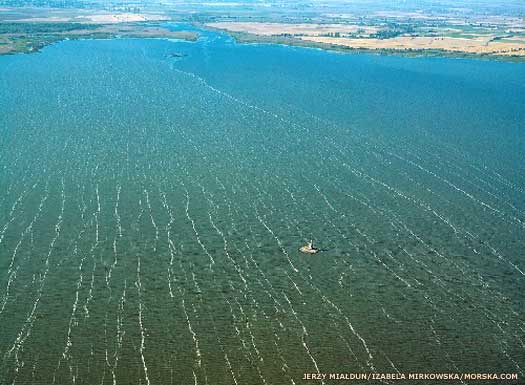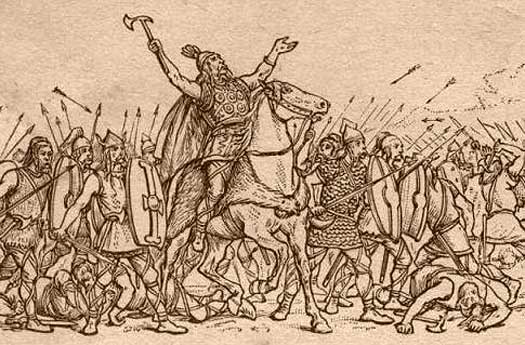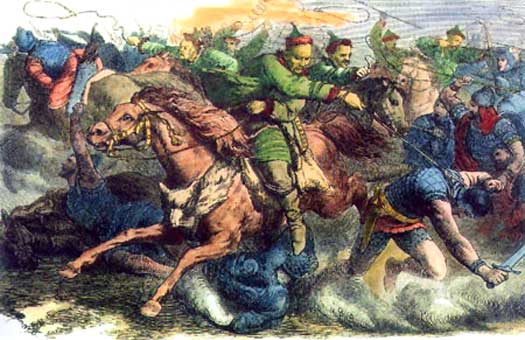| c.200 |
From around AD 150 the Goths gradually renew their migration, moving slowly southwards from the Oder and Vistula inWillenberg Poland, heading on a path that will eventually take them into Ukraine. They appear to draw the neighbouring Gepids in their wake, along with the Scirii, who enter Galicia around AD 200. Some authors have the Bastarnae migrating alongside them as close neighbours, but it appears that this tribe was already in the region of the Danube delta by the second century BC. Instead, the two tribes may become neighbours later in the third century, when the Scirii themselves arrive on the Danube.  The Scirii almost certainly migrated southwards from the area around the mouth of the Vistula - shown here at part of its great estuary - along with their East Germanic cousins The Scirii almost certainly migrated southwards from the area around the mouth of the Vistula - shown here at part of its great estuary - along with their East Germanic cousins |
|
| 267/268 - 269 |
The Peucini Bastarnae are specifically mentioned in the invasion across the [Roman](ItalyRomeEmpire.htm#Soldier Emperors Secundas) frontier. Part of the barbarian coalition which includes Goths and Heruli, they use their knowledge of boat building from several centuries of living on the Black Sea coast and in the Danube estuary to help build a fleet in the estuary of the River Tyras (now the Dniester). This is the first historical record of the Heruli, and the Scirii should probably be included alongside them, at a time at which they probably neighbour the Bastarnae, living to the east of them on the Black Sea coast. The Heruli and the Goths are classed by Rome as pirates who ravage the coasts of Greece and Asia Minor. |
|
| 375 |
The invading Huns subjugate the Ostrogoths and Heruli in the vast territory they occupy in what is now Ukraine and areas of southern Russia, creating a vast kingdom of their own which survives until the death of Attila in 453. Elements of the Scirii are to be found in the Carpathians, probably left behind during the migration to the Danube, and they too are subjugated. |
|
| 409 |
According to vague information, the Scirii are attacked in Dacia Ripensis and are resettled in lower Moesia, along the southern bank of the Danube. A further resettlement places them on the River Waag (Vah in western Slovakia), to the north of the Danube. However, despite these resettlements, the tribe still appears to be subject to the Huns. |
|
| 451 |
To preserve their new domains, the Visigoths fight on the side of [Rome](ItalyRomeEmpire.htm#AD 434) to halt the advance of the Huns at the Battle of the Catalaunian Plains, in the former territory of theCatalauni. Attila is aided by his own subjugated allies, which includeGepids, Ostrogoths, Rugii, Scirii, andTaifali. Although both sides fight to a standstill, it is Attila who withdraws and it is seen as his first major defeat, ending his reputation for invincibility.  Despite his great success over the barbarian tribes of eastern and Central Europe, Attila's stalemate against an allied Roman-led army in 451 was a blow to his prestige, and his death soon afterwards caused his empire to crumble Despite his great success over the barbarian tribes of eastern and Central Europe, Attila's stalemate against an allied Roman-led army in 451 was a blow to his prestige, and his death soon afterwards caused his empire to crumble |
|
| fl 454 |
Edika / Edico / Idico |
Possible king or tribal noble. |
| 456 - 457 |
In their fight for independence from the Huns, the Ostrogoths under Valamir defeat and rout Attila's sons. They inherit control of Pannonia as a result, and absorb elements from other, smaller tribes, such as the Scirii. During the subsequent thirty years, the Ostrogoths edge slowly southwards into the Balkans, and then head westwards towards Illyria and the borders of Italy. Other Scirii join the Visigoths, while others still become foederati in the Roman empire. |
|
| fl 470 - 493 |
Odoacer / Odovacar |
Son? King of Italy (476-493). Killed. |
| c.470 |
Odoacer's origins are a little uncertain, with most general records simply naming him as a Gothic general. It seems likely that he is a Scirian by birth, although again some sources name him as a Turcilingi, a tribe which he leads. It may be that he is of both tribes, with his mother originating from the Turcilingi. This tribe is very small and almost completely obscure, appearing briefly for the span of a generation from the middle of the fifth century. That alone suggests that it is either a short-lived splinter group from a larger tribe (almost certainly the Scirii), or is in fact another tribe whose name has been confused or misheard. The Thuringians are proposed in the second instance, but their geographical location would seem to make this highly unlikely. Instead, the Turcilingi, if not a mistake, are probably a section of the Scirii, perhaps Odoacer's own personal warband. |
|
| 470 - 472 |
Odoacer enters Italy with the Heruli,Rugii, and Sciiri around 470, although the latter is certainly only a portion of the tribe and may only be his own warband. He joins the Roman army and quickly rises to a position of command. In 472 he and his troops from various tribes rebel and aid the powerful German magister militum, Ricimer, in his bid to make Olybrius emperor. Both Ricimer and Olybrius soon die, and in the ensuing struggle a Roman officer, Orestes, becomes magister militum.  The collapse of the Hunnic empire freed large numbers of Germanic tribes to migrate in all directions, founding new kingdoms and disruption the Roman empire The collapse of the Hunnic empire freed large numbers of Germanic tribes to migrate in all directions, founding new kingdoms and disruption the Roman empire |
|
| 476 |
Orestes reneges on his promise to give Odoacer's people their land. Odoacer, with Eastern Roman backing, kills Orestes, deposes Emperor Romulus and rules Italy as a Gothic Roman state while his Germanic followers gain the land they had been promised. |
|
| 489 - 493 |
The Ostrogoths are invited to invade Italy by the Eastern Roman emperor and overthrow the troublesome Odoacer. The Ostrogoths immediately win the Battle of Isonzo on 28 August 489, and Odoacer is forced to withdraw. A second battle is fought at Verona in the same year. In 493 Theodoric takes Ravenna and he and Odoacer subsequently sign a treaty that divides Italy between them. At a banquet to celebrate the terms, Theodoric murders Odoacer with his own hands. Now unopposed, he is able to found a RomanisedOstrogothic kingdom of Italy, and the Scirii who came with Odoacer are subjugated. |
|
| c.500 |
The [Bavarii](GermanyBavarians.htm#Bavarian Confederation) confederation forms in the territory that later becomes Bohemia, immediately following the exodus of the Langobards towards Italy. The confederation is made up from local elements, which include possibleCeltic Boii descendants and Roman settlers, along with elements of the Germanic Alemanni,Heruli, Marcomanni, Ostrogoths (following the fall of their own kingdom), Quadi, Rugii, Scirii, andThuringians. Within a few decades the Bavarii migrate (or expand) southwards to occupy a larger territory which later forms Bavaria and parts of Austria. There, they are subjugated by theFranks around 555, but may not remain fully under Frankish domination, if at all. It is not until the Carolingian conquest of 788 that independence is definitely lost. |
|
 |
|
|
 Scirii (Germanic) Incorporating the Turcilingi The Germanic tribes seem to have originated in a homeland in southern Scandinavia (Sweden and Norway, with the Jutland area of northern Denmark, along with a very narrow strip of Baltic coastline). They had been settled here for over two thousand years following the Indo-European migrations. The Germanic ethnic group began as a division of the western edge of late proto-Indo-European dialects around 3300 BC, splitting away from a general westwards migration to head towards the southern coastline of the Baltic Sea. By the time the Germanic tribes were becoming key players in the politics of Western Europe in the last two centuries BC, the previously dominant Celts were on the verge of being conquered and dominated by Rome. They had already been pushed out of northern and Central Europe by a mass of Germanic tribes which were steadily carving out a new homeland. The Scirii were a small East Germanic tribe that was settled mainly in Eastern Europe. Between the first century BC and the second century AD they were located along the lower reaches of the eastern side of the Vistula, in modern Poland. They appear to have been sandwiched into a small section of territory between the Gepids to the immediate north and the Goths to the south, with elements of the Venedi and Aestii to the north-east, the greater Venedi to the east, and the Rugii across the Vistula to the west. Also known as the Scirians, Schiri, or Skiri, the tribe was closely linked to the Heruli, perhaps being their subjects, and there were also possible links to the Goths. The Heruli themselves were subject to the Goths and their later Ostrogoth division until the latter were defeated by the Huns in 375. The Turcilingi seem to have been a very small and almost completely obscure splinter unit of the fifth century. The meaning of the tribe's name is unknown, and there are a range of theories that try to explain it. One suggests that it is based on the Germanic term for 'clean-' or 'pure-bloods' as opposed to the Bastarnae 'mixed-bloods' who neighboured them in the late third century AD. Another links the name to the term 'shire', a Germanic word for a division of land that was rendered in Old English as 'scir' and in Old High German as 'scira'. That would suggest that the 'tribe' was nothing of the sort, but was instead a division of a greater tribe, possibly the Heruli or Gepids. (Information by Peter Kessler, with additional information by Edward Dawson, from Complete Works of Tacitus, Alfred John Church, William Jackson Brodribb, & Lisa Cerrato (1942), from Roman History by Cassius Dio, translation by Earnest Cary (1914-1927), from Germania, Tacitus, from Roman Soldier versus Germanic Warrior: 1st Century AD, Lindsay Powell, from The Horse, the Wheel, and Language: How Bronze-Age Riders from the Eurasian Steppes Shaped the Modern World, David W Anthony, from Geography, Ptolemy, and from External Link: Geography, Strabo (H C Hamilton & W Falconer, London, 1903, Perseus Online Edition).)
Scirii (Germanic) Incorporating the Turcilingi The Germanic tribes seem to have originated in a homeland in southern Scandinavia (Sweden and Norway, with the Jutland area of northern Denmark, along with a very narrow strip of Baltic coastline). They had been settled here for over two thousand years following the Indo-European migrations. The Germanic ethnic group began as a division of the western edge of late proto-Indo-European dialects around 3300 BC, splitting away from a general westwards migration to head towards the southern coastline of the Baltic Sea. By the time the Germanic tribes were becoming key players in the politics of Western Europe in the last two centuries BC, the previously dominant Celts were on the verge of being conquered and dominated by Rome. They had already been pushed out of northern and Central Europe by a mass of Germanic tribes which were steadily carving out a new homeland. The Scirii were a small East Germanic tribe that was settled mainly in Eastern Europe. Between the first century BC and the second century AD they were located along the lower reaches of the eastern side of the Vistula, in modern Poland. They appear to have been sandwiched into a small section of territory between the Gepids to the immediate north and the Goths to the south, with elements of the Venedi and Aestii to the north-east, the greater Venedi to the east, and the Rugii across the Vistula to the west. Also known as the Scirians, Schiri, or Skiri, the tribe was closely linked to the Heruli, perhaps being their subjects, and there were also possible links to the Goths. The Heruli themselves were subject to the Goths and their later Ostrogoth division until the latter were defeated by the Huns in 375. The Turcilingi seem to have been a very small and almost completely obscure splinter unit of the fifth century. The meaning of the tribe's name is unknown, and there are a range of theories that try to explain it. One suggests that it is based on the Germanic term for 'clean-' or 'pure-bloods' as opposed to the Bastarnae 'mixed-bloods' who neighboured them in the late third century AD. Another links the name to the term 'shire', a Germanic word for a division of land that was rendered in Old English as 'scir' and in Old High German as 'scira'. That would suggest that the 'tribe' was nothing of the sort, but was instead a division of a greater tribe, possibly the Heruli or Gepids. (Information by Peter Kessler, with additional information by Edward Dawson, from Complete Works of Tacitus, Alfred John Church, William Jackson Brodribb, & Lisa Cerrato (1942), from Roman History by Cassius Dio, translation by Earnest Cary (1914-1927), from Germania, Tacitus, from Roman Soldier versus Germanic Warrior: 1st Century AD, Lindsay Powell, from The Horse, the Wheel, and Language: How Bronze-Age Riders from the Eurasian Steppes Shaped the Modern World, David W Anthony, from Geography, Ptolemy, and from External Link: Geography, Strabo (H C Hamilton & W Falconer, London, 1903, Perseus Online Edition).) The Scirii almost certainly migrated southwards from the area around the mouth of the Vistula - shown here at part of its great estuary - along with their East Germanic cousins
The Scirii almost certainly migrated southwards from the area around the mouth of the Vistula - shown here at part of its great estuary - along with their East Germanic cousins Despite his great success over the barbarian tribes of eastern and Central Europe, Attila's stalemate against an allied Roman-led army in 451 was a blow to his prestige, and his death soon afterwards caused his empire to crumble
Despite his great success over the barbarian tribes of eastern and Central Europe, Attila's stalemate against an allied Roman-led army in 451 was a blow to his prestige, and his death soon afterwards caused his empire to crumble The collapse of the Hunnic empire freed large numbers of Germanic tribes to migrate in all directions, founding new kingdoms and disruption the Roman empire
The collapse of the Hunnic empire freed large numbers of Germanic tribes to migrate in all directions, founding new kingdoms and disruption the Roman empire